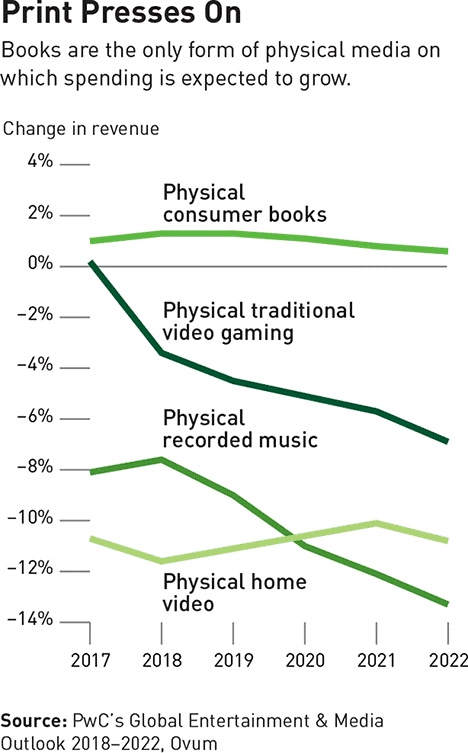The digital revolution hit the print media industry right between the eyes. In the past 10 years, we’ve seen dramatic changes in consumer consumption in just about every media category. Yet according to PWC’s Global Entertainment & Media Outlook 2018-2022, the market for physical, printed consumer books is holding its own.

“The media and entertainment industry has a long history of embracing disruptive innovations, from the printing press to the personal computer,” writes Bob Woods in strategy+business. He notes rapids shifts from physical to digital in DVDs, CDs and video gaming, as noted in the PWC report.
“But the oldest form of physical media is actually holding up quite well,” he continues. “Between 2018 and 2022, sales of physical video games, home video, and music are expected to decline each year, in some instances by double-digit percentages. By contrast, sales of physical books are expected to grow modestly, by about 1 percent annually, every year.”
The PWC findings echo other recent findings that e-books sales have hit a wall.
“According to AAP, e-book sales in 2017 fell for the third consecutive year, off 4.7 percent from 2016, to $1.1 billion from $1.16 billion,” Woods notes.
Why? According to Woods, there are two factors at play – one emotional, and one business.
First off, people continue to love the experience of reading physical books. And while the older generations seem more in tune this, plenty of younger readers are favoring the experience. And they are heavy consumers of books from which hit movies have been made – witness the popularity of print titles like Gone Girl, Harry Potter and The Hunger Games to name just a few.
On the business side, streaming and subscription-based models have skewered the video, music and gaming industries.
“Business models surrounding media, especially those that drive unit prices down through streaming or subscription models, also help explain the differing trajectories of books and other physical media,” Woods notes. “Consider how the markets for physical music and video have been undercut by disruptive business models. In both realms, the world quickly evolved so that consumers could get access to identical digital versions of the physical media at a tiny fraction of the cost.”
That didn’t happen in the book industry – and doesn’t seem likely too either. As Woods notes, the price difference between a print and a digital book is not all that much … and for the additional few dollars per title, it seems readers will opt for the print version. We value the physical over the digital when it comes to a good book.
Will the trend hold in the long-term? Indie bookseller Roxanne Coady of R. J. Julia ponders that question.
“My worry now is that baby boomers are in the shedding mode, not the acquisitive mode,” she laments, noting there’s only so much time in the day to consume media of any sort. “If there were a finite amount of time given to culture, the portion of [boomer’s kids’} time going to books would be different from baby boomers. We’re trying to figure out what that looks like.”
James DePonte of PWC agrees that the time we spend reading books may decrease, but likely by smaller degrees than other media.
For now, he agrees that “print books have done fine” in the current landscape. We believe the primary fact is that print books are an immersive, engaging experience and we crave that as humans. The physical has importance in this age of transience; when so much of what we consume is temporary, print has a lasting quality that transcends the news feed. And we need more of that in our lives.
